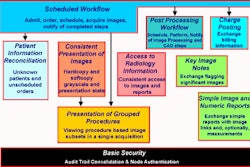PACS and connectivity provider Merge Technologies has signed a definitive agreement to acquire Canadian PACS developer eFilm Medical in a stock deal currently valued at over $8.5 million. Milwaukee-based Merge will pay one million shares of its common stock, which was trading at $8.63 early Wednesday.
The firms are already familiar with each other, having participated in joint product development of image distribution technology in the past year. In addition, eFilm provides Merge with a customized version of its workstation software.
Merge will run eFilm as a wholly owned subsidiary and has no plans to change eFilm's operations, Merge vice president of marketing Beth Frost-Johnson told AuntMinnie.com. The acquisition, which is expected to close within 30 to 60 days, is subject to closing conditions.
eFilm's profitability, positive cash flow, and revenue base from multiyear service and software licensing contracts will add long-term accretive value to Merge, said Merge president and CEO Richard Linden.
Known primarily for its free workstation software, Toronto-based eFilm has been seeking to generate additional revenues with a subscription model and sales of complementary digital image management software.
eFilm has achieved enviable interest in its product, having logged about 20,000 registered downloads of its free image viewer around the world. The software can be used for a wide range of image viewing applications, including teleradiology as well as diagnostic and clinical review environments, according to the vendor.
In response to customer requests for additional services, eFilm launched a subscription model that guarantees software updates and provides access to service and support, beginning at $500 (U.S.) per client license. Site licenses are also available. In addition, eFilm offers a radiology information system, as well as a server to meet back-end image and information storage requirements, according to the vendor.
Ultimately, eFilm plans to attract additional paying customers through its suite of add-on integrated electronic medical record (EMR) workflow offerings, according to president and CEO Gregory Couch.
"What we've been trying to do is make that (concept of) a RIS/PACS as two separate systems (interfaced) with back-end HL7 connectivity disappear, and offer that as a fully integrated application," Couch said.
So far, eFilm has attracted 1,200 paid licenses for version 1.7 of its viewing software, which was released in November 2001. The company has also completed installation of its first PACS networks at two hospitals in the U.K.
A homegrown PACS
eFilm evolved from a PACS development initiative at the University Health Network (UHN) and Mount Sinai Hospital (MSH) in Toronto. The two institutions, which together perform approximately 500,000 imaging studies annually at four hospitals, decided five years ago to develop their own PACS network instead of procuring a commercial PACS.
The institutions formed a PACS group, which in 1998 developed what it called eFilm medical imaging software, an open-architecture PACS viewer. In addition to its role as a viewing application for UHN and MSH, the software was also made available for free downloading over the Internet.
The PACS group also developed a RIS, which was placed into clinical use at UHN in late 1999. The client-based RIS is now used by all four hospitals over their intranet, according to the company.
In May 2000, the PACS group was converted into a private firm. eFilm still maintains service contracts with the original four hospitals.
The release of version 1.7 marked the debut of eFilm's subscription model. The viewer was the first eFilm product to receive Food and Drug Administration 510(k) clearance; it has also received the European CE Mark, and clearance from Health Canada.
In May, eFilm plans to release version 1.8, which adds features such as multiplanar reformatting (MPR) and orthopedic templating. Dynamic wavelet-based image transmission, developed in collaboration with Merge and image compression developer HREF="http://www.auntminnie.com/default.asp?Sec=tec&Sub=ven&Pag=10591">Pegasus Imaging of Tampa, FL, has also been incorporated.
"This allows the package to be used for high-speed, server-driven viewing in a local area network all the way up to teleradiology over very poor (bandwidth) lines," Couch said. "It also gives the user the ability to decide what level of compression they're comfortable working with on an image-by-image basis."
Images can also be dynamically refined from a lossy to lossless format, as users are looking at the study, Couch said.
eFilm uses a network-attached storage (NAS) approach for image storage, and their system can support a range of archiving media, including digital linear tape (DLT) and DVD, according to the company. A Web application, called eFilm X, employs an Active X control for Web-based distribution.
"We can provide a fully scalable PACS that includes, for instance, a Web server, all-in-one," Couch said.
eFilm can furnish its services via a software-only model, or through a bundled offering that includes hardware, he said. The company encourages institutions to own the hardware themselves, however, allowing sites to leverage existing IT infrastructure and budgets, said COO Catherine McCallum.
In addition to direct sales, eFilm markets its technology and services through a distributor network. The firm has also provided customized versions of eFilm to Merge and Amicas of West Newton, MA. Merge said that it believes its value-added reseller (VAR) customer base will complement eFilm's distributor partnerships.
By Erik L. RidleyAuntMinnie.com staff writer
April 17, 2002
Related Reading
Merge releases ImageChannel, November 6, 2001
Merge partners with eFilm, February 8, 2001
Copyright © 2002 AuntMinnie.com




















